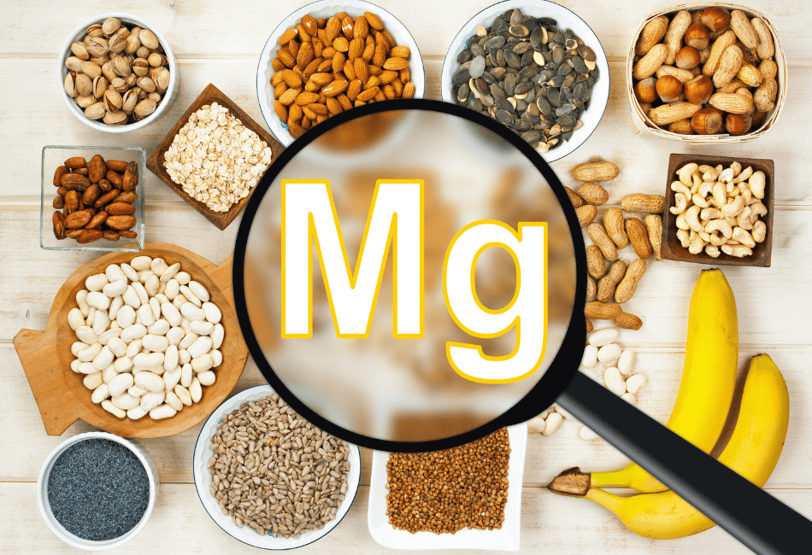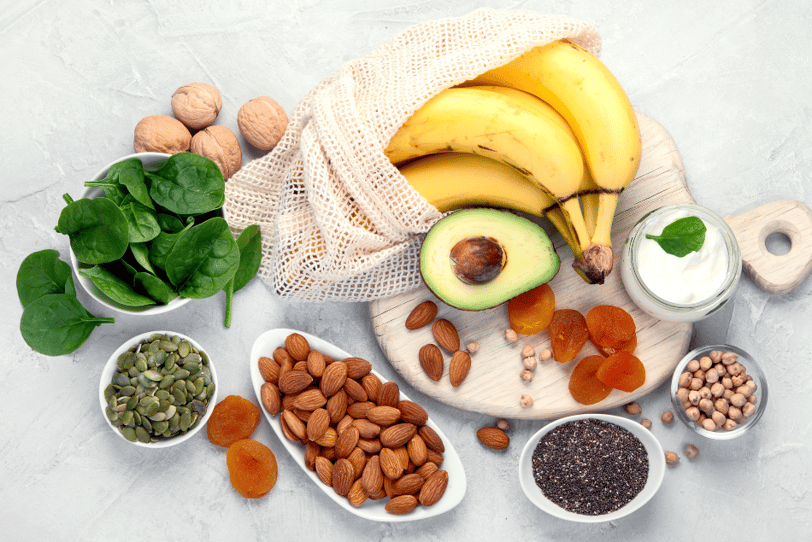Foods Rich In Magnesium
Foods Rich in Magnesium explores essential dietary sources of this vital mineral. Discover comprehensive nutritional content, expert preparation tips, and three easy recipes to help you incorporate more magnesium into your diet for better sleep, muscle function, and overall health.
HELPFUL TIPS
4/5/20255 min read


Are you constantly feeling tired, experiencing muscle cramps, or having trouble sleeping? Your body might be trying to tell you something—you could be missing out on magnesium! This mighty mineral is like the unsung hero of your body, quietly powering over 300 different processes that keep you feeling energized and healthy. Yet despite its importance, many of us aren't getting enough in our daily diets. The good news? Nature has packed plenty of delicious foods with this essential nutrient, and you're about to see exactly which ones to add to your shopping list. From crunchy nuts to creamy avocados and even (yes!) dark chocolate, boosting your magnesium intake can be both easy and delicious.
Why Magnesium Matters
Magnesium is involved in numerous bodily functions including:
Muscle and nerve function
Blood glucose control
Blood pressure regulation
Protein synthesis
Bone development and maintenance
DNA and RNA synthesis
Energy production
Sleep regulation
The recommended daily allowance (RDA) for magnesium is:
Adult men: 400-420 mg
Adult women: 310-320 mg (350-360 mg during pregnancy)
Top Magnesium-Rich Foods
Adding these magnesium powerhouses to your diet can help you meet your daily requirements naturally:
Nuts and Seeds
Pumpkin seeds: 156 mg per ounce (37% of RDA)
Chia seeds: 111 mg per ounce (26% of RDA)
Almonds: 80 mg per ounce (19% of RDA)
Cashews: 74 mg per ounce (18% of RDA)
Leafy Greens
Spinach: 78 mg per ½ cup cooked (19% of RDA)
Swiss chard: 75 mg per ½ cup cooked (18% of RDA)
Kale: 31 mg per cup raw (7% of RDA)
Whole Grains
Quinoa: 118 mg per cup cooked (28% of RDA)
Brown rice: 42 mg per cup cooked (10% of RDA)
Oatmeal: 63 mg per cup cooked (15% of RDA)
Legumes
Black beans: 60 mg per cup cooked (14% of RDA)
Lentils: 71 mg per cup cooked (17% of RDA)
Edamame: 50 mg per cup (12% of RDA)
Other Sources
Dark chocolate (70-85% cacao): 65 mg per ounce (16% of RDA)
Avocados: 44 mg per medium avocado (11% of RDA)
Bananas: 32 mg per medium banana (8% of RDA)
Plain yogurt: 42 mg per cup (10% of RDA)
Fatty fish: 26-35 mg per 3-ounce serving (6-8% of RDA)
Expert Tips for Maximizing Magnesium Absorption
Dr. Elizabeth Somer, registered dietitian and author of "Food & Mood," offers these insights:
Pair with vitamin D: "Vitamin D helps with magnesium absorption. Consider spending 10-15 minutes in the sun or consuming vitamin D-rich foods alongside magnesium-rich ones."
Limit processed foods: "Refined grains and processed foods have had much of their magnesium stripped away. Focus on whole, unprocessed foods."
Be careful with supplements: "While supplements can help, food sources are always preferable as they provide additional nutrients that work synergistically with magnesium."
Watch your calcium intake: "Too much calcium can interfere with magnesium absorption. Maintain a balanced ratio of these minerals."
Consider preparation methods: "Lightly steaming vegetables preserves more nutrients than boiling, which can leach minerals into the water."
Delicious Magnesium-Rich Recipes
Spinach and Pumpkin Seed Salad with Avocado
Serves: 2 Prep time: 10 minutes
Ingredients:
4 cups fresh spinach leaves
1 medium avocado, diced
1/4 cup pumpkin seeds
1/4 cup sliced almonds
1 small red onion, thinly sliced
1 tablespoon olive oil
1 tablespoon lemon juice
Salt and pepper to taste
Instructions:
Combine spinach, avocado, pumpkin seeds, almonds, and red onion in a large bowl.
Whisk together olive oil and lemon juice for dressing.
Toss salad with dressing, season with salt and pepper.
Nutritional Information (per serving):
Calories: 325
Protein: 9g
Carbohydrates: 16g
Fat: 28g (healthy fats)
Fiber: 9g
Magnesium: 225mg (53% of RDA)
Quinoa Black Bean Bowl
Serves: 4 Prep time: 15 minutes Cook time: 20 minutes
Ingredients:
1 cup quinoa, rinsed
2 cups vegetable broth
1 can (15 oz) black beans, drained and rinsed
1 red bell pepper, diced
1 cup cherry tomatoes, halved
1 avocado, sliced
1/4 cup pumpkin seeds
2 tablespoons lime juice
2 tablespoons olive oil
1 teaspoon cumin
1/2 teaspoon chili powder
Fresh cilantro for garnish
Salt and pepper to taste
Instructions:
Cook quinoa in vegetable broth according to package directions.
While quinoa cooks, prepare vegetables and mix lime juice, olive oil, cumin, and chili powder for dressing.
When quinoa is done, fluff with a fork and let cool slightly.
Combine quinoa, black beans, bell pepper, and tomatoes in a large bowl.
Drizzle with dressing and toss to combine.
Top with avocado slices, pumpkin seeds, and cilantro.
Nutritional Information (per serving):
Calories: 390
Protein: 12g
Carbohydrates: 45g
Fat: 18g
Fiber: 11g
Magnesium: 180mg (43% of RDA)
Dark Chocolate Chia Pudding
Serves: 2 Prep time: 5 minutes Setting time: 4 hours or overnight
Ingredients:
1/4 cup chia seeds
1 cup unsweetened almond milk
2 tablespoons dark cocoa powder
2 tablespoons maple syrup
1/2 teaspoon vanilla extract
1 ounce dark chocolate (70%+), chopped
Fresh berries for topping
Instructions:
In a bowl, whisk together almond milk, cocoa powder, maple syrup, and vanilla.
Stir in chia seeds until well combined.
Refrigerate for at least 4 hours or overnight, stirring occasionally in the first hour.
Before serving, top with chopped dark chocolate and fresh berries.
Nutritional Information (per serving):
Calories: 285
Protein: 7g
Carbohydrates: 32g
Fat: 16g
Fiber: 14g
Magnesium: 160mg (38% of RDA)
Storage and Preparation Tips for Magnesium-Rich Foods
Nuts and Seeds
Store in airtight containers in a cool, dark place for up to 3 months
For longer storage, refrigerate (up to 6 months) or freeze (up to 1 year)
Toasting nuts and seeds briefly enhances flavor without significant nutrient loss
Leafy Greens
Store unwashed in the refrigerator with a paper towel to absorb moisture
Use within 3-5 days for optimal nutrition
Quick cooking methods (steaming, sautéing) preserve more nutrients than boiling
Whole Grains
Store in airtight containers in a cool, dry place
Soaking whole grains before cooking can increase mineral availability
Cook in mineral-rich water rather than distilled water for added nutrient content
Legumes
Dried beans keep for 1-2 years in airtight containers
Soaking and sprouting legumes reduces phytic acid, which can inhibit mineral absorption
Cooking with a strip of kombu seaweed can enhance mineral content and improve digestibility
Signs of Magnesium Deficiency
Be aware of these potential indicators that you might not be getting enough magnesium:
Muscle cramps and twitches
Fatigue and weakness
Mental health issues like apathy or irritability
Irregular heartbeat
Osteoporosis
High blood pressure
Asthma
If you suspect a deficiency, consult with a healthcare provider before starting any supplements.
Conclusion
Incorporating magnesium-rich foods into your daily diet is a delicious way to support your overall health. From supporting bone health to improving sleep quality and reducing stress, this mighty mineral delivers impressive benefits. By focusing on a variety of whole foods like leafy greens, nuts, seeds, whole grains, and legumes, you can easily meet your daily magnesium needs through your diet.
Sources
National Institutes of Health Office of Dietary Supplements. (2022). Magnesium Fact Sheet for Health Professionals. https://ods.od.nih.gov/factsheets/Magnesium-HealthProfessional/
Rosanoff, A., Weaver, C. M., & Rude, R. K. (2012). Suboptimal magnesium status in the United States: are the health consequences underestimated? Nutrition Reviews, 70(3), 153-164.
Gröber, U., Schmidt, J., & Kisters, K. (2015). Magnesium in Prevention and Therapy. Nutrients, 7(9), 8199-8226.
USDA FoodData Central. (2023). https://fdc.nal.usda.gov/
Schwalfenberg, G. K., & Genuis, S. J. (2017). The Importance of Magnesium in Clinical Healthcare. Scientifica, 2017, 4179326.
Disclaimer:
The information provided in this article about magnesium-rich foods, nutritional content, and health benefits is for educational and informational purposes only. It is not intended to replace professional medical advice, diagnosis, or treatment. Always seek the guidance of your physician or other qualified health provider with any questions you may have regarding a medical condition or before making significant changes to your diet, especially if you have existing health concerns, are pregnant, nursing, or taking medications.
Nutritional values provided are approximations and may vary based on specific brands, preparation methods, and serving sizes. While we strive for accuracy, we cannot guarantee that the nutritional information is error-free.
Individual nutritional needs vary based on age, gender, weight, activity level, and health status. The recipes and dietary suggestions in this article may not be suitable for everyone. Please consult with a registered dietitian or healthcare provider for personalized nutrition advice.
The author and publisher of this content are not responsible for any adverse reactions, effects, or consequences resulting from the use of any recipes, suggestions, or procedures described in this article.


Easy Healthy Recipes for Busy Cooks
Connect
© 2025 All rights reserved.


